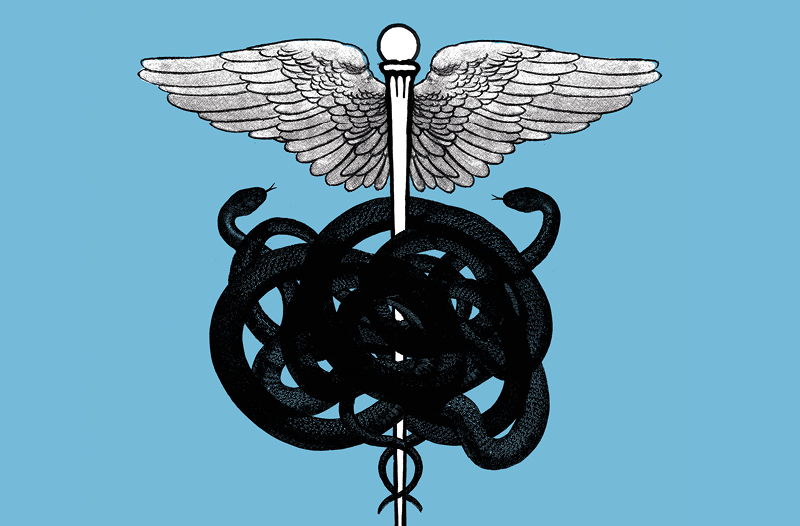
The Costly Consequences of Comorbidities

When workers compensation collides with existing health conditions, a complex situation can quickly worsen for all involved.
Recently, a workers compensation claimant with brokerage Woodruff Sawyer needed ankle surgery following an on-the-job injury, but her blood glucose was too high (an A1c level of about 15, more than double the minimum to be considered diabetes). The doctor wouldn’t operate at that level, but the woman was not interested in controlling her A1c. Her employer had no alternative job responsibilities she could fill, so she was not working but still being paid for time lost.
That’s when a workers compensation provider must step in and put extra resources into the claim to try to expedite the healing or stop the loss—for example, a nurse to provide the claimant with nutritional advice and encourage taking prescribed medication— and document if they aren’t compliant. But a person can’t lower their A1c level that dramatically overnight, or even in a month. Woodruff Sawyer worked on the claim for several months until it could prove to the doctor that the claimant wasn’t doing what she needed to get better and be declared medically stationary, meaning she wasn’t likely to improve or worsen and would no longer be eligible for benefits.
“Then we can stop the bleeding; and if the person is ready later, they can come back and have the surgery,” says Leslie Newman, senior workers compensation claim consultant at Woodruff Sawyer. “Doctors will do that—say they are medically stationary—but it does take a lot of resources and time to get there. And time is money on a workers comp claim.”
Managing workers compensation claims often means dealing with factors well beyond the initial injury. That includes increasingly common comorbid chronic health conditions including hypertension, diabetes, depression, and obesity, which often have nothing to do with that injury. These conditions can delay recovery time, increase the severity of the injury and complexity of the claim, and dramatically boost costs. In response, workers compensation carriers are using loss control strategies and working with employers to reduce excessive costs and downtime when comorbidities hinder the claims process.
A Costly Proposition
In an August 2025 report, the Workers Compensation Research Institute found that, of nearly 1 million claims studied with seven or more days of lost time, about 39% of claimants had at least one comorbid condition. About 22% involved one condition, almost 10% had two comorbidities, and roughly 7% included three or more. Degenerative conditions such as osteoarthritis or spinal disc diseases were the most frequent comorbidity, showing up in about 19% of all claims and roughly one-third of orthopedic-related claims like back and shoulder injuries.
Costs and time off at least doubled when comorbid conditions were involved, the Institute reported. Average workers compensation claims payments without comorbidities were around $10,000 for both medical and indemnity costs. For claims that involved one comorbidity, payments rose to about $20,000 for medical and $25,000 for indemnity. For two conditions, they reached just over $30,000 for each; for three, it was about $45,000 for medical and just over $40,000 for indemnity; and when four or more were involved, claims costs hit roughly $81,000 for medical payments and $60,000 for indemnity. The average time of disability was about 10 weeks with no comorbidities and rose steadily to 55 weeks with four or more conditions.
In a 2016 report analyzing more than 7,000 workers compensation claims, Harbor Health Systems found that claims that included multiple comorbidities lasted 76% longer and increased costs by 341% compared to those without. Temporary total disability days were 285% higher with claims including multiple comorbidities, litigation rates were 147% higher, and surgery rates rose by 123%.
Various comorbidities can differently impact workers compensation claims, but higher costs and longer recovery periods are common outcomes. Here, we’ll look at several prevalent conditions.
Diabetes
About 39 million Americans (approximately 11.6% of the U.S. population) have diabetes. A vast majority of those suffer from Type 2 diabetes, which (unlike Type 1) primarily develops in adults whose body becomes resistant to insulin or does not generate sufficient insulin. Additionally, almost 98 million people have prediabetes, which means their blood sugar level is high though not yet considered diabetes. More than 6% of the adult working population has been estimated to be diabetic.
Diabetes impacts how the body uses sugar, or glucose, usually resulting in a person having too much sugar in their blood. This can impede healing from an injury or wound. An extended period of high blood sugar can damage blood vessels, making it more difficult for blood to flow and take oxygen and nutrients to damaged tissues and organs. When someone with diabetes has a wound, there is often more inflammation, less tissue regrowth, and fewer healthy cells that migrate to the wound to begin the healing process.
Generally, medical costs for people with diabetes are higher than for those who don’t have the condition. That extends to workers compensation bills.
A claim involving a fractured forearm equates to about 43 days of disability, according to healthcare company Optum. Adding diabetes to the mix is likely to extend the disability period to 62 days. If a person with uncontrolled diabetes—meaning their blood glucose isn’t well regulated—needs surgery, they have a 43.5% chance of the wound reopening afterward, a 26.1% chance of returning to the operating room, and an 11% chance of infection, Optum says. The numbers for someone who doesn’t have diabetes for those same outcomes are 19.3%, 12.9%, and 6.5% respectively.
“We see diabetes a lot in adults ages 40 to 60,” Newman says. “When you have diabetes as a comorbidity and then you injure your foot or ankle, tissue heals slower and there is a loss of blood flow. I had a claim recently where an employee injured his foot, but the injury was so much more dire because he had diabetes. He had surgery and it wouldn’t heal, so they had to take him back and do surgery again and it cost a lot of money.”
Just having diabetes can place a person at higher risk of an accident in the workplace. A main side effect of some diabetes medications is low blood sugar which, if severe, can cause symptoms including tremors, weakness, blurry vision, confusion, and unconsciousness. These symptoms can lead to falls and other accidents. High blood glucose can also damage bones over time, increasing the risk of fractures.
A 2024 study published in the Journal of Diabetes Investigation found that people with uncontrolled diabetes had a 1.25 higher risk of a workplace accident than people whose diabetes is controlled. Diabetic employees who weren’t receiving continuous treatment were four times more likely to have an accident.
Obesity
The Harbor Health study found that surgery rates for a workplace injury increased by 140% for people when the claims involved obesity. Claim duration was also 55% longer when a claimant was obese.
With nearly one-third of the U.S. workforce dealing with obesity (a body mass index of 30 or above), and another third overweight (BMI of 25 to 30), this issue will impact many employers.
Obesity also increases a person’s risk for a workplace injury. Though the increased risk varies slightly by sector— for example, an overweight person in the construction industry may have a greater risk of injury than a white-collar worker—Global Data reported in 2024 that people with obesity are 26% to 107% more likely to have an occupational injury than people at a healthy weight.
Obesity can make people more susceptible to heat stress because activity can increase their core temperature more than a thinner person doing the same activity. It is also more difficult for someone who is overweight to regulate their body temperature due to less efficient blood flow from the core to the skin. Obesity can increase the risk of falls because of reduced physical agility, flexibility, and balance. The health condition also puts people at higher risk of sleep apnea, which leads to daytime fatigue that can then lead to car or machinery accidents. The Global Data report estimated that about one-third of injuries overweight people sustain at work are directly linked to their weight.
In addition, obesity can extend the workers compensation claims period. The condition has been shown to increase inflammation in the body and may reduce blood flow to an injured area. Both can prolong the time for an injury to heal. Obesity may also hinder a person’s ability to participate in physical therapy because it adds stress to the joints during common movements during the treatment. It may also require different treatments than for someone who isn’t obese.
Obesity is also related to higher short-term and long-term disability and workers compensation payments, according to Global Data. Expenses related to obesity (aside from the actual injury) in claims were as much as $1,857 per worker in the construction industry. These could include costs for higher inpatient stays and prescription drugs.
Hypertension
About 30% of the adult workforce has high blood pressure, also known as hypertension. High blood pressure, if not treated, can contribute to stroke, heart attack, or kidney disease.
Hypertension can delay healing time and prolong claims by various means. Over time, hypertension can harden arteries, reducing the amount of oxygen that reaches a wounded area to help it heal. Someone with uncontrolled high blood pressure may have to delay surgery until they receive treatment to regulate their blood pressure. Doctors may also have to use alternative treatments for the workplace injury because certain medications, including corticosteroids and nonsteroidal anti-inflammatories, have been shown to raise blood pressure.
A 2012 report by the National Council on Compensation Insurance (NCCI) found that per-claim medical costs averaged about $2,500 for all claims. But claims with hypertension as a comorbidity cost more than $15,500.
Mental Health and Substance Misuse
Mental health conditions and substance misuse may not have a direct physical impact on healing after a workplace injury. But conditions have been shown to prolong claims and increase their costs.
A 2024 study in the Journal of Neurosurgery studied the outcomes of workers compensation patients who had spinal surgery. About 11% of all claimants had anxiety or depression. Workers compensation claimants without a mental health condition reported having less back pain and better quality of life one year post-surgery than claimants with a mental health condition.
Other research has borne this out. NCCI, for example, found that having a substance misuse disorder can increase workers compensation claims by as much as 22%.
Harbor Health reported that a comorbid substance misuse condition can extend a person’s claims duration by 67%. Temporary total disability days were 274% higher for people who had a comorbid substance misuse condition than those who didn’t. Having a mental health condition also increased the chances of litigation by 248%; comorbid substance misuse did so by 224%. Common types of litigation by claimants include denial of payment and disagreements on the amount of disability and benefits.
Mental health and substance misuse can prolong claims because workers with anxiety or depression may lack the motivation to maintain care plans or physical therapy, says Melissa Burke, head of client experience at AmTrust Financial. They may feel ostracized from their co-workers or depressed at the idea of returning to work if their duties are modified. Depression is also shown to increase the risk of other comorbidities like hypertension, stroke, heart disease, and coronary artery disease.
“Mental health issues can have more of an impact than physical health on claims,” Burke says. “Anxiety and fear and catastrophic thinking can extend their time out and drive their fear of returning to work. And if someone has anxiety before their claim even starts, the injury could exacerbate that.”
Arthritis
Nearly 59 million U.S. adults have arthritis, according to the Centers for Disease Control and Prevention. The condition, inflammation in the joints that causes swelling, stiffness, and pain, is the second-largest driver of employee healthcare costs, at about $304 billion in medical spending and lost earnings annually, the Arthritis Foundation says.
Many kinds of jobs can exacerbate arthritis. For example, sedentary work can aggravate muscle pain; repetitive motions can worsen, or cause, arthritis in some joints; and heavy lifting can stress joints, making them more susceptible to future issues.
Arthritis can also slow healing following an injury. Some types, like rheumatoid arthritis, can cause vasculitis, or inflammation of small blood vessels in the skin. If there is already inflammation around the injury, vasculitis can compound this effect. When an injury occurs, inflammation is one of the body’s initial, and natural, responses to help clear bacteria and prepare the wound to heal. During the next stages of healing, growth factors, immune cells, and reactive oxygen species are released, helping the wound to clot, eliminating foreign pathogens, and removing products broken down from the injured cells. Excessive inflammation interferes with these other stages, leading to tissue destruction and excessive bacteria, among other health threats.
Some medications for treating rheumatoid arthritis, known as biologics, suppress the immune system, which may also slow wound healing.
Smoking
Though not a chronic health condition, smoking should not be ignored here given that one-fifth of the U.S. workforce uses tobacco products.
Employers on average pay over $2,000 more for workers compensation claims of smokers than they do for non-smokers, according to One Call Care Management, which provides ancillary care solutions to the workers compensation industry.
Cigarette smoking can cause hypoxia, or a reduction in the amount of oxygen in the body’s tissues. Following surgery, hypoxia can increase the risk of wound infection. It can extend the time it takes a wound to heal following surgery. One 2005 study found that smokers with open-leg fractures never reached complete healing of their bones. They also had almost three times the risk of bone infections.
An Ounce of Prevention
With the growing number of people in the workplace who have one or more comorbidities, many workers compensation companies are taking steps to help clients control their risks—particularly since people with comorbidities are more likely to have a claim, which workers compensation providers want to avoid. Burke says AmTrust Financial talks with companies about preemployment health screenings, drug testing, having modified job duty descriptions in place, and smoking cessation if they have a high proportion of smokers in the workplace.
“We could direct them to their group health plan for smoking cessation,” she says. “From the client experience team perspective our goal is to tell insureds what we see in their claim trends that may not be on their mind. We identify those opportunities before it’s in their view and bring them to their attention.”
Rehabilitation hospital operator PAM Health tries to anticipate issues with employers as well, and to head them off with preventive care, says Eric Patten, national director of strategic initiatives for workers compensation. This is a space, he says, that workers compensation groups are wrestling with—how involved with employee health they can, and should, be prior to receiving claims.
“That’s where we have to engage with all parties, group health payers and maybe a company’s human resources people, and say we need to try to explore this [preventive coverage] and what does that look like?” he says.
Offering resources such as free health checkups or diabetes and hypertension testing helps employers identify many chronic conditions early, which can help stave off higher medical and workers compensation bills later, according to Patten. For direct preventive care, employers can provide longer lunch periods so employees can go for walks or bring in a nutritionist to counsel workers on their eating habits.
“You’re not going to change the person who’s non-compliant, but you might be able to help sway them towards being a little bit more compliant with a chronic illness that he or she may have,” Patten says. “It’s about being as preventive and proactive as possible.”
Ensuring a health plan has preventive care may help employers reduce downstream costs, This is especially true in states such as California, where employers are responsible for paying for comorbid conditions that may impede progress of the claim.
“Based on the state, it may require the claim pay for smoking cessation or weight loss,” Newman says. “I’ve even seen times where someone had to have a gastric bypass to lose the necessary weight. It doesn’t mean the claim owns that condition or has to pay for diabetes treatment for the rest of their life, but they do have to help manage it during the claim period.”
Early Identification
Because employers may have to pay for some treatment of preexisting conditions, it’s imperative to understand any claimant comorbidities early in the workers compensation process.
Adjusters should talk with claimants about any impactful health issues shortly after the claim is filed, Burke says. Some carriers, such as AmTrust, have a triage program where a nurse asks questions to identify any comorbidities that might change management of the claimant’s case—such as offering behavioral health telehealth services to a claimant with preexisting anxiety or depression. Burke says AmTrust also tries to guide claimants to providers in its network with experience in managing workers compensation claims.
“Our in-network providers are thinking about these other potential impacts while keeping the scope aligned to the work injury,” she says. “We want to stay within our guardrails but understanding the injured employee as a whole person will help improve the injury that occurred. There are many tools in an adjuster and nurse’s toolbox to identify whether or not we need to address those comorbidities.”
Patten says workers compensation providers sometimes must delve into areas that traditional health insurers don’t want to cover. For instance, a person might have borderline high cholesterol, hypertension, or prediabetes that is not yet technically diagnosable, so their insurance won’t pay for medication. But if a doctor can’t operate on someone for fear of complications, the claimant will remain on workers compensation until they are healthy enough, prolonging the cost and time of the claim. To avoid the protracted claim, the insurer may pick up the tab on some of those treatments.
Workers compensation should also more frequently pay for continuous glucose monitors if someone has uncontrolled high blood sugar, Patten believes. These provide regular glucose readings and can help people regulate their blood sugar more quickly than using a finger stick, which is cheaper but offers less data.
Another area workers compensation is considering paying for is GLP-1 receptor agonists for weight loss.
“GLP-1s take center stage in the comp space because they improve diabetes and help reduce weight, which puts less stress on knees, hips, and backs,” Patten says. “The injury isn’t compounded by 110 extra pounds of weight or diabetes that isn’t controlled.”
Though GLP-1s can be expensive, workers compensation providers can purchase the medications direct from pharmaceutical companies for about $500 a month for four weekly doses, he says. This makes it easier to justify the return on the upfront investment.
“We are trying to figure out if it behooves the comp industry to say, for the next four months, we’ll pay for the $2,000 so you can reduce your weight, which reduces our exposure and reserves by tenfold,” Patten adds.
Persuading a claimant to take medication or other steps to improve their health, such as therapy for depression, may be easier if couched in the umbrella of workers compensation. Instead of telling someone to lose weight or see a therapist, insurers can demonstrate that they care about the claimant’s health, with the goal of returning to work. Patten suggests offering treatment for their injury along with nutritional counseling or a free gym membership—and letting them know that these resources will help reduce their recovery time and get them back on the job sooner. If these therapies work, employees may stick with them after the injury heals, which helps their health over the long term, he says.
It Takes a Village
While claims adjusters or medical professionals try to identify any claimant comorbidities early on, that is not always possible. An initial assessment for an injury may occur in an emergency room or urgent care, where the provider probably isn’t conducting a full health workup. Even when talking to adjusters, some people don’t feel comfortable giving health information.
Woodruff Sawyer’s Newman says it can take time to obtain a person’s full health picture. Comorbidities may not come to light until conservative treatments fail and need to be evaluated. If someone is not returning to work in the time anticipated, Newman says her organization looks at the person’s medical records or enlists nurse triage to call the claimant to find out if there is an underlying cause delaying the healing process.
Adjusters deal with many claims and sometimes let people “sit in physical therapy for six months,” Newman says. She instructs clients to re-evaluate at the 90-day mark to make some kind of decision on continuing care.
“If someone isn’t better in 90 days, and we don’t have a great plan to move it forward, we have problems on our hands,” Newman says.
Workers compensation cases shouldn’t just include the claimant, their doctor, and the claims adjuster. It’s usually best to have a multipronged approach that also involves the employer and nurse navigators.
When thinking about risk control, Burke says AmTrust staff talks with employers about their organization’s workplace culture. Along with emphasizing preventive care, they can offer a robust employee assistance program (EAP) and ensure there is no stigma around mental health or substance misuse, both of which prolong claims.
Management of workers compensation claims also tells a lot about workplace culture, according to Burke. If people don’t report safety issues or there is a long lag between an injury occurring and being reported, it could mean employees don’t feel comfortable with their employer. If this happens often, she works with employers to improve the workplace ethos through means such as management training, encouraging employees to report claims quickly, and establishing return-to-work policies.
Newman says employers should never underestimate the importance of frequent contact with the claimant. They should know the organization is there to help with any issues and will work with the adjuster to return the employee to health.
“The more interaction and more caring they show, the less likely the claim is to become litigated,” she says. “Tell them, ‘We know you are injured and if you aren’t feeling great, come talk to us. I know this is going to be frustrating, but there are a lot of people you can talk to.’”
Newman also says one of the most important things employers can do is have a return-to-work program with modified duty for the claimant. Having an employee engaged and back at work helps claims resolve faster, she says. Return-to-work programs also help avoid comorbid mental health issues; she says most claimants say their injury is causing depression within 30 days of filing a claim.
“When I give a work comp 101 presentation, I always talk about why engagement is so important,” Newman says. “If you’ve got an awesome EAP program and BetterHelp [therapy], and a whole suite of things, make sure that claimant is made aware and taking advantage of those resources.”




